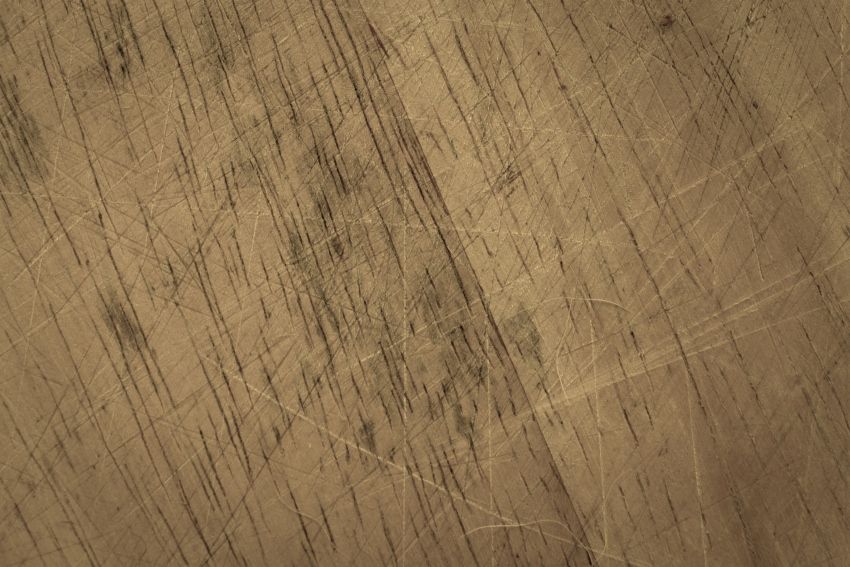How to Remove Scratches on Engineered Wood Floors

Engineered hardwood floors are popular for many reasons including their longevity both in terms of the timeless quality of their look and the durability of the material.
Durable, however, doesn't mean they are impossible to damage and accidents DO happen, that is a fact of life. So, what to do when your beautiful, engineered hardwood floor suffers a scratch or scratches?
Firstly, don't panic, like we said, accidents happen and we have all the tips and advice you need right here on how to get rid of scratches on engineered wood floors.
Understanding Engineered Hardwood Floors
To understand what can be done to repair scratches on engineered hardwood floors it helps to understand their composition.
Engineered hardwood floors are comprised of several layers of plywood bonded together and topped with a real solid hardwood veneer. This top layer varies in thickness depending on various factors including price and depending on the thickness can potentially be sanded down and refinished just like solid hardwood flooring a number of times.
Advantages & Disadvantages of Engineered Hardwood Floors
Engineered hardwood floors have all the advantages of solid wood flooring and more besides.
Advantages of Engineered Hardwood Include:
Suited to any age or style of property.
Great for those with allergies.
Durable.
Lasts decades.
Can come in many different shades and finishes.
The natural beauty of the wood grain.
Easy to clean and maintain.
Water-resistant - composite bonded layers prevent water from seeping in.
Economical choice.
Better able to withstand changes in temperature than solid wood.
Disadvantages of Engineered Hardwood Include:
Susceptibility to scratches.
Can be damaged by incorrect cleaning and maintenance - using abrasive cleaners etc.
Susceptible to staining if spills are not cleaned up straight away.
More expensive than laminate.
Factors Contributing to Scratches on Engineered Hardwood Floors
Some of the most common contributing factors to scratches on engineered hardwood are walking in high-heeled shoes on the engineered hardwood, pet's claws, furniture being pulled or dragged across the floor without the use of felt pads and grit or other sharp pieces of debris getting caught under furniture or rugs and then scraping across the floor.
Assessing the Severity of Scratches
Not all scratches on engineered hardwood are equal. To fix scratches on engineered wood flooring you first need to establish the severity of them.
Firstly, there are surface scratches, these light scratches affect the finish of the wood rather than the wood itself. They are caused by everyday activity including foot traffic and day-to-day furniture movement (chairs etc).
Further up the severity scale are moderate scratches. These scratches affect the finish AND the wood underneath but are not too deep. Often caused by pets or larger-sized pieces of furniture being moved; tables etc. These scratches might take a bit of effort to fix but can be easily undertaken by anyone with some basic handiwork skills.
Finally, there are deep or major scratches. These penetrate the wood deeply and are usually caused by very heavy or sharp items being dragged across the floor. Fridges and washing machines are common culprits! To fix major scratches on engineered floors you might want to consider hiring a professional unless you are confident in your ability to fix scratches yourself.
Preparing the Work Area & Cleaning the Scratched Area
You don't want to accidentally create more scratches when trying to fix scratches so before you begin sweep the area thoroughly with a soft brush and wipe with a damp cloth.
You could, if you prefer, use one of the recommended cleaning products from our suppliers.
If you are fixing more than one scratch at a time, use masking tape to clearly mark the areas you will be working on.
Also, ensure you have all the tools you need before you start.
Fixing Minor Scratches
Minor, surface scratches which affect only the protective coating or finish of your engineered hardwood flooring can sometimes be fixed with fine-grit sandpaper. Gently smooth over the scratch and then simply re-finish the small area as required.
Depending on the type of finish you can also try using a ready-bought scratch concealer. These are applied with a soft, lint-free cloth, any excess is carefully wiped away and will dry quickly with the help of light.
Sanding and Refinishing Moderate and Deep Scratches
If the above steps don't work, or you know your scratch goes a little deeper then it might require a more thorough fix.
You can use a specific engineered hardwood scratch repair kit, wood filler or floor repair wax which you should be able to find at good home improvement stores. Find one in a shade that matches your floor or choose 2 or more shades that you can blend together.
You will need to follow the instructions but as a general rule the method will be along these lines:
Clean and prepare the floor (as described above).
Ensure your colour matches your floor.
Apply the wax or other mixture with a plastic putty knife.
Wipe away any excess.
Clean with a damp lint-free cloth.
Seal and refinish with the same product your floor was originally finished with.
Repairing Deep Scratches
Sanding and refinishing your floor should remove any and all deep scratches and depending on the thickness of the hardwood layer your engineered wooden floor can be sanded several times over its lifetime.
If the scratches on your engineered hardwood floors are extremely deep you might consider replacing the planks affected.
It is recommended that you approach a professional to do this level of repair.
Preventive Measures
Of course the best solution is to avoid having to fix scratches on engineered wood floors in the first place.
Ensure grit and other sharp debris can't scratch your floor by sweeping with a soft brush at least daily.
When moving heavy furniture place protective coverings over your wood floors and use trolleys wherever possible.
For day-to-day furniture movement ensure that all your furniture has felt pads on the feet; check and replace these regularly.
You can also protect high-traffic areas or areas where pets and children play and where shoes are worn or spills are likely with rugs.
Conclusion
Although engineered wooden floors are among the most robust and, with the right finish, are among the most damage-resistant types of flooring you can get; accidents do happen.
But scratches and other damage can be camouflaged or fixed with the right tools and/or assistance and needn't affect the aesthetic appeal or the return on investment of your floor.


